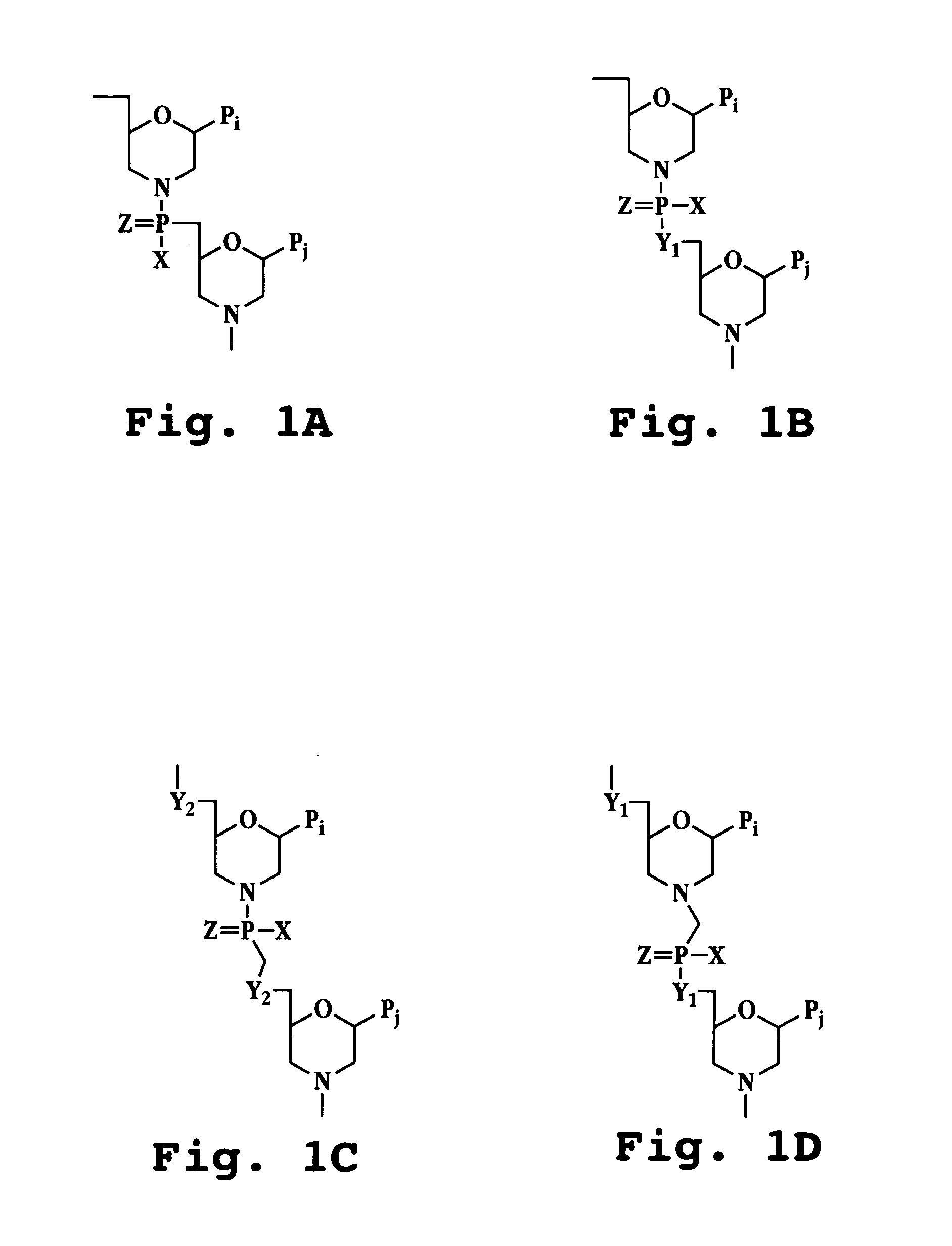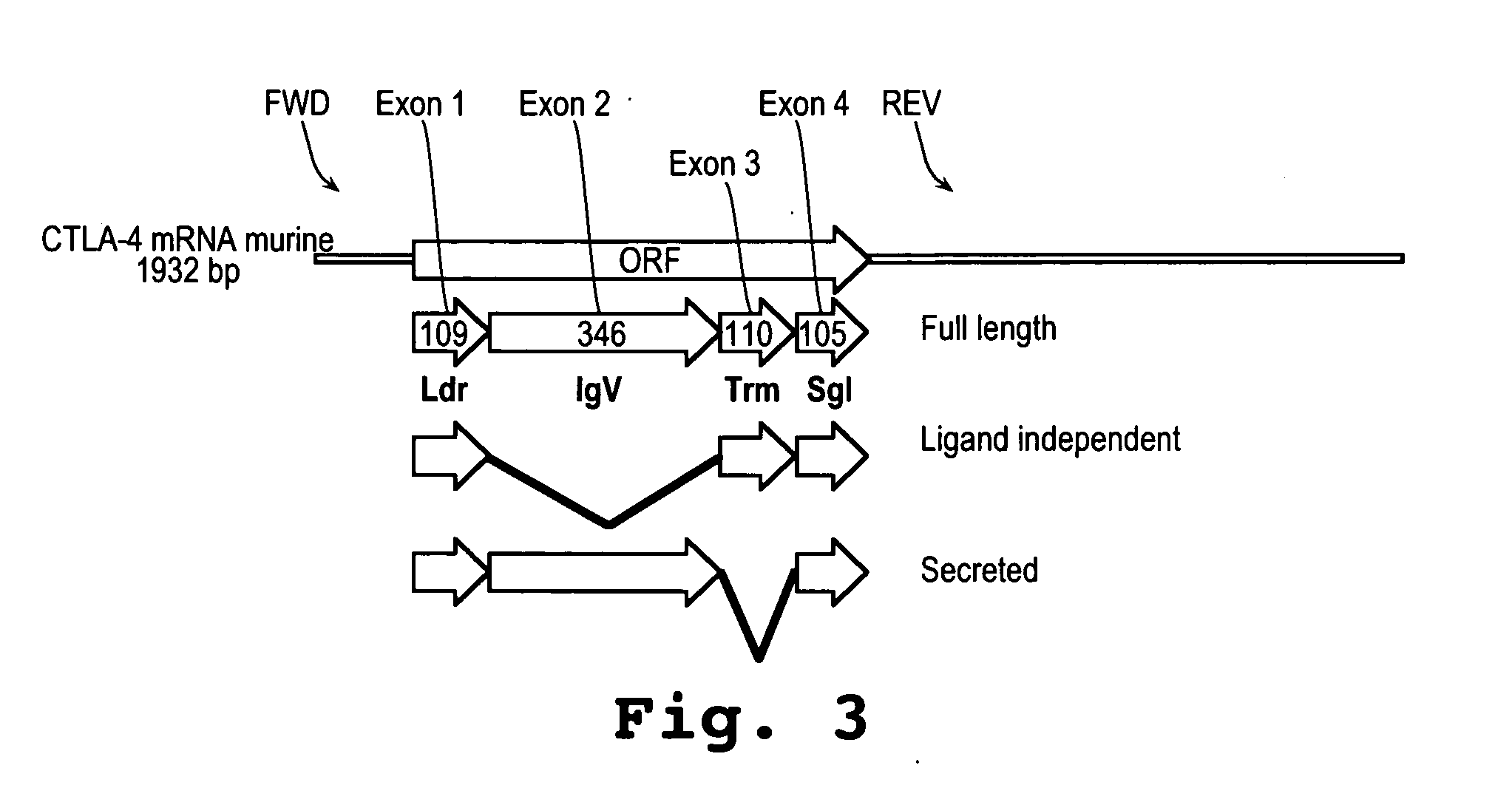Immunosuppression compound and treatment method
a technology of immunosuppression compound and treatment method, which is applied in the direction of biocide, group 5/15 element organic compounds, genetic material ingredients, etc., can solve the problems of inability to achieve long-term results, and inability to respond to treatment. , to achieve the effect of suppressing the immune response and increasing the ratio of processed mrna
- Summary
- Abstract
- Description
- Claims
- Application Information
AI Technical Summary
Benefits of technology
Problems solved by technology
Method used
Image
Examples
example 1
Splice-altered mRNAs Derived from B6 and NOD Splenocyte After Treatment with PMOs Targeting Splice Donor or Splice Acceptor Sequences
[0157] CTLA-4 mRNA isoforms were examined by RT-PCR using messenger RNA (mRNA) isolated from B6 splenocytes stimulated with mitogen and treated with the various PMOs (10 micromolar) in culture for 24 hours. Alterations to the size of the products were observed by agarose gel electrophoresis stained with EtBr and are shown in FIG. 4A. PMOs targeting splice acceptor sites (SA) were more efficient for altering splicing compared to those targeting splice donor sites (SD). FIG. 4B shows the results of RT-PCR examination of mRNA derived from NOD splenocytes treated with PMOs. A similar splice alteration pattern as was seen for PMO-treated B6 splenocytes is induced in cells treated with as little as 0.5 micromolar PMO targeting SA2 (muCTLA-4SA2; SEQ ID NO:1 1). FIG. 4C is a control expertiment and shows that protein molecules related to CTLA-4 (ICOS and CD28...
example 2
The Effect of CTLA-4 Splice Altering PMOs on T Cell Activation, Proliferation and Adhesion Activity
[0159] The early activation T cell marker CD69 was examined by flow cytometry after 16hr treatment with anti-CD3 antibody and with or without treatment with muCTLA-4SA2 PMO (SEQ ID NO:11) at a 5 micromolar concentration. The resulting diminution in CD69 expression compared to untreated stimulated cells demonstrates an influence of the PMO on the activation state of the T cells. The graph in FIG. 6 shows CD69 levels gated on CD4 +cells.
[0160] The influence of splice altering CTLA-4 PMOs on cell proliferation is shown in FIG. 7. Purified mouse T cells were labeled with CFSE and then stimulated with anti-CD3 antibody. The cells were cultured for 48 hrs with either PMO (5 micromolar) or anti-CTLA-4 antibody or isotype. Cellular division was examined by flow cytometry gating on live cells. Proliferation was inhibited by the CTLA-4 agonist antibody and by treatment with the muCTLA-4SA2 PMO...
example 3
Treatment of NOD Mice with CTLA-4 PMOs
[0162] To examine the in vivo effect of the CTLA-4 splice altering PMOs, NOD female mice were treat with splice altering PMOs muCTLA-4SA2 or muCTLA-4SA3 (SEQ ID NOs: 11 and 12, respectively) or a PMO targeting translation of the CTLA-4 protein AUG (see Materials and Methods). Animals (n=12 / group) were treated with PMO (150 microgram i.p.) in 200 microliter saline for 2 weeks starting at age 8 weeks and blood sugar levels (b.s.l.) monitored weekly. Animals exhibiting a b.s.l. above 250 were terminated. As shown in FIG. 9, animals treated with muCTLA-4SA2 developed disease at a point ˜ 2 weeks later than controls. A greater percentage of animals developed disease when treated with the muCTLA-4SA3 PMO.
[0163] To examine the effect of a therapeutic treatment of NOD mice with the muCTLA-4SA2 PMO, a series of animals were monitored weekly for b.s.l. Treatment with muCTLA-4SA2 PMO (200 micrograms / day i.p. for 14 days) began when b.s.l. exceeded 140 mg...
PUM
| Property | Measurement | Unit |
|---|---|---|
| Temperature | aaaaa | aaaaa |
| Time | aaaaa | aaaaa |
| Mass | aaaaa | aaaaa |
Abstract
Description
Claims
Application Information
 Login to View More
Login to View More - R&D
- Intellectual Property
- Life Sciences
- Materials
- Tech Scout
- Unparalleled Data Quality
- Higher Quality Content
- 60% Fewer Hallucinations
Browse by: Latest US Patents, China's latest patents, Technical Efficacy Thesaurus, Application Domain, Technology Topic, Popular Technical Reports.
© 2025 PatSnap. All rights reserved.Legal|Privacy policy|Modern Slavery Act Transparency Statement|Sitemap|About US| Contact US: help@patsnap.com



